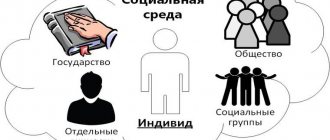Hello, dear readers of the KtoNaNovenkogo.ru blog. Who are the marginalized anyway, to put it simply? People who, of their own free will, did not want to be part of society, or were they kicked out by society?
Or are these the people who are just standing next to the company on the side? Such a sensational word, but not everyone knows exactly what this concept means. I'll say more. The meaning of this word is quite vague. Many people understand when and to whom it can be applied, but they cannot give a definition. But you and I will try.
Who is a marginalized person: definition of the term
In its original form, this concept came from sociology, but subsequently moved into other areas: psychology, social science, etc. This is why it is so important to determine the real meaning of the word marginal. A marginal personality is usually understood as a person cut off from any social group. Such people have a number of sociological and behavioral characteristics that justify their separation into a special system.
Marginal is an asocial object, which is not necessarily equivalent to dysfunctional, immoral or suffering from pathological attachments and bad habits.
This term first appeared in the United States in the 1920s in relation to people freed from slavery who, thanks to freedom, left one social group, but did not have time to adapt to any other. A large number of marginalized people also emerged during the period of urbanization, when young people began to abruptly leave their native villages and move to big cities. Today the word marginal is often used in relation to people with a low level of culture, morality and education.
Who are the marginalized and where do they come from?
Who can be classified as a marginalized population?
Those who are called marginalized in today's realities are, in fact, most often lumpen. The unforgettable Karl Marx included beggars, vagabonds, bandits, and degenerate people into this layer of the population.
According to the prevailing stereotype, marginalized people and lumpen people have common interests and lead a similar lifestyle. This is not entirely true.
What is the difference between marginalized people and lumpen people?
Lumpens are morally degraded people who are at one of the stages of degradation and are gradually descending lower and lower, approaching an animal state. The marginalized can be lumpen, but not always. Marginalized are those who do not fit into society, have their own philosophy and lead a lifestyle that is unusual for those around them.
Who can be considered marginalized:
- Voluntary hermits who do not recognize social values (downshifters, freelancers);
- Migrants who were unable to integrate into the cultural environment of the country in which they now live;
- People who left their usual place of life (village residents in the city and vice versa);
- People with physical disabilities or mental illness;
- Carriers of dying national cultures;
- Adherents of bad habits to an extreme degree (gamblers, drug addicts, alcoholics);
- Followers of religious minorities, sectarians;
- Those who belong to radical political movements preach terrorism;
- People who find themselves below the poverty line;
- Those released from prison after a long period of restriction of freedom.
Signs of marginalia
There are several main signs that characterize a marginal personality:
- Severance of economic, social and spiritual ties that exist in the “pre-marginal” period of life. Often this status is assigned to migrants, refugees and military personnel discharged from service. Such people find themselves on the periphery and cannot always adequately adapt to new conditions. Finding himself in such a situation, a person can declassify - fall to the social “bottom”.
- Developing your own value system, and sometimes hostility towards the current society, legislation, etc.
- Mobility – arises due to the lack of housing and attachments.
- Mental and psychological problems that manifest themselves on the basis of unfulfillment.
- Tendency to engage in illegal activities.
The marginal label can be imposed on a person by society or adopted by the individual independently.
Difference from lumpen
The term “lumpen” was first introduced by K. Marx. He called it people who had become vagabonds, beggars and bandits. According to the population, the lumpen and the marginal are one and the same group of people. However, it is not.
Lumpen is a classless, physically and morally lost person. They are part of the marginalized, but a marginal personality is not always lumpen.
Types of marginalized people
If events develop favorably, the period of marginality for a person lasts relatively short. A strong personality can easily join a new social group, find a job and realize his own needs. The exception is people who became marginalized not of their own free will, but due to some external circumstances (refugees) or those who consciously chose this way of life (extremists, radicals, revolutionaries, etc.). Over the past period of time, sociologists have identified several types of marginality.
Political marginality
The most striking example of political marginality is the rise to power of Fidel Castro in Cuba, accompanied by bloody repression and unrest. The new treasure of life became almost unbearable for more than 2 million men and women who decided to flee to other countries. Thus, refugees were marginalized - they became individuals who did not accept the existing political regime and its laws.
Ethnic marginality
Most often, people born from parents of different nationalities become ethnic marginals. It is important to understand that not every interethnic union gives rise to marginalized people. This phenomenon is observed only when the child does not want to identify himself with any parental nationality. In addition, the ethnic marginalized include:
- national minorities;
- extremely small peoples.
Religious marginality
The majority of people consider themselves to belong to a particular religion or adhere to atheism. A religious fringe is a person who believes in the existence of a higher power, but cannot associate himself with any existing religion. Among such marginalized people you can find people who founded their own church.
Social marginality
Social marginality arises against the backdrop of cataclysms and external factors: social upheavals, wars, natural disasters, etc. Large groups of people instantly lose their social status and are forced to seek it in new conditions.
Economic marginality
The economic marginalized include:
- unemployed;
- people living at the expense of the state or another person;
- men and women who do not want to develop in the professional field.
Today, super-rich people who are cut off from society are also called economic marginals. Thanks to the benefits received, they can often change their place of residence, try themselves in a new field, etc.
Biomarginality
In an ideal system of society, people should take care of those who, for some reason, find themselves in a difficult life situation. Unfortunately, theory often differs from practice, which is why in the modern world there is biological (natural) marginality. This type includes people who do not have a socially useful function and are among the most vulnerable layers: disabled people, old people, chronically ill people, children with syndromes, etc.
Yes
100%
No
0%
Voted: 3
Famous personalities
A striking example of marginalized individuals is the settlement of entire neighborhoods by New York emigrants, the Chinese of China Town and the Russians of Brighton Beach. Many newcomers cannot integrate into American society or change their values to new ones. The reason for this is their existing mentality.
Another example is Russian society, which in the 90s of the 20th century was divided into two groups. One included representatives of the lower strata of society, the other - new Russians. Both were called marginalized.
World-famous writers, poets, scientists, and artists were considered marginal individuals. During their lifetime, their dissimilarity with other representatives of society, lack of understanding of their views and creativity forced society to classify them as insane, outcasts.
The modern world has identified another group - people who devote all their free time to the computer, living in virtual reality.
Examples of marginalized people in history include:
- Diogenes - philosopher of Ancient Greece;
- S. Razin - a Cossack from the Don who led the peasant uprising that occurred in 1670-1671;
- E. Pugachev - a Ukrainian peasant, under whose leadership a peasant uprising took place in Podolia in 1813-1835.
Literature has its own marginalized individuals. These are considered to be:
- J. Moriarty - from “The Sherlock Holmes Series” by Arthur Conan Doyle;
- O. Bender - from “The Twelve Chairs” by Ilf and Petrov;
- P. Sharikova - from “Heart of a Dog” by Mikhail Bulgakov;
- R. Raskolnikova - from “Crime and Punishment” by Fyodor Dostoevsky;
- E. Bazarova - from “Fathers and Sons” by Ivan Turgenev.
In any society at any time there were marginalized people. Every full-fledged member of society must act in such a way that marginalized individuals have the conditions to live normally and fully in society.
Pros and cons of marginality
The original meaning of a marginal lifestyle has been somewhat transformed, and therefore carries not only a negative, but also a positive load.
Advantages and disadvantages
Mobility and flexibility
A penchant for innovation and everything new
Enrichment of culture and creation of a new social group
Confusion and inability to act effectively in new circumstances
Some destabilization of society
Inability to adapt to a new role
Loss of former values
Possibility of lumpenization
In most cases, society suffers from marginalization, since this phenomenon is most often associated with any radical changes - revolutions, riots, etc. This can lead to the destabilization of the economy and politics, as well as the outflow of promising and highly intelligent individuals.
Artificially created marginality also carries a negative connotation. In this case, the number of marginalized people will begin to grow exponentially, which will lead to the death and lumpenization of innocent people, in particular small children. Examples of artificial marginalization of society are: the Holocaust of the Jewish nation, as well as Stalinist repressions.
Bottom line
Marginality may seem like a negative quality. However, it has its advantages:
- The ability to see what society does not see.
- The ability to be detached, mobile, easy-going.
- Fearlessness, because the marginalized is not attached to anything.
The negative aspect of marginality is loneliness in the big world of people, where no one understands a person and treats him negatively. Often those around them are subject to stereotyped thinking, which is excluded in the case of the marginalized.
Marginality and poverty
Many people mistakenly believe that marginalized groups include only degraded and impoverished individuals. As noted earlier, such elements may also include super-rich people, who, due to their wealth, become freer than other members of society. Quite often, successful and wealthy businessmen strive for a quieter life, so they conduct business in the city and live in the province or village. This is why marginality cannot be associated with lack of money or imprisonment.
The phenomenon of downshifting is of particular interest in the current structure of society. From birth, a person develops in two directions at once: as a social unit and an individual personality. Ideally, these forces should be in a balanced position, but in reality one of the vectors may outweigh. With increased socialization, a conformist appears, and with increased individualization, a downshifter appears.
A downshifter is a person who has chosen to live outside society or has deliberately limited his social connections outside the family. Such an outcast is quite happy with being in a borderline state, since he can travel freely, live independently of anyone, etc. Downshifters have strong energy and unconventional thinking, so they prefer to engage in creativity and art.
Examples of famous marginalized people
The most famous outcasts:
- Jesus Christ is a religious marginality.
- Diogenes of Sinope - ancient Greek philosopher.
- Leo Tolstoy denied most of the privileges of the noble class, preferred to live in the countryside and worked in a rather revolutionary direction.
- Emelyan Pugachev - leader of the Peasant War.
It should be noted that marginalized people have existed throughout history. In the modern world, this phenomenon has received a new round of development.
The spread of the Internet has contributed to the formation of a new marginal group of freelancers who prefer to work not in a team, but independently from anywhere in the world. Socially, this phenomenon has been virtually unstudied.








